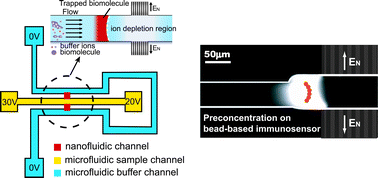Pre-binding dynamic range and sensitivity enhancement for immuno-sensors using nanofluidic preconcentrator†
Abstract
Almost all immuno-biosensors are inherently limited by the quality of antibodies available for the target molecule, and obtaining a highly sensitive antibody for a given target molecule is a challenge. We describe a highly efficient and flexible way to enhance immunoassay detection sensitivity and binding kinetics using a nanofluidic based electrokinetic preconcentrator. The device is a microfluidic integration of charge-based biomolecule concentrator and a bead-based immunoassay. Because the preconcentrator can increase the local biomolecule concentration by many orders of magnitude, it gives the immuno-sensor better sensitivity and faster binding kinetics. With a 30 min preconcentration, we were able to enhance the immunoassay sensitivity (with molecular background) by more than 500 fold from higher 50 pM to the sub 100 fM range. Moreover, by adjusting the preconcentration time, we can switch the detection range of the given bead-based assay (from 10–10 000 ng ml−1 to 0.01–10 000 ng ml−1) to have a broader dynamic range of detection. As the system can enhance both detection sensitivity and dynamic range, it can be used to address the most critical detection issues in the detection of common disease


 Please wait while we load your content...
Please wait while we load your content...